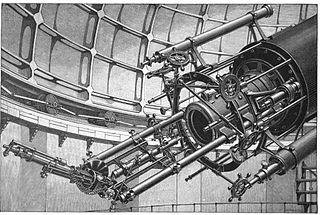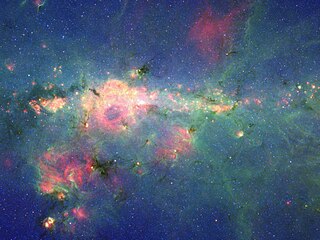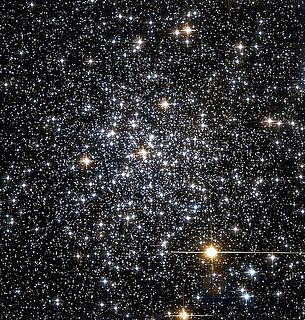Related Research Articles

A globular cluster is a spherical collection of stars. Globular clusters are very tightly bound by gravity, giving them their spherical shapes and high concentrations of stars toward their centers. Their name is derived from Latin globulus—a small sphere. Globular clusters are occasionally known simply as globulars.

Microscopium is a minor constellation in the southern celestial hemisphere, one of twelve created in the 18th century by French astronomer Nicolas-Louis de Lacaille and one of several depicting scientific instruments. The name is a Latinised form of the Greek word for microscope. Its stars are faint and hardly visible from most of the non-tropical Northern Hemisphere.

A planetary nebula, is a type of emission nebula consisting of an expanding, glowing shell of ionized gas ejected from red giant stars late in their lives.

Photometry, from Greek photo- ("light") and -metry ("measure"), is a technique used in astronomy that is concerned with measuring the flux or intensity of light radiated by astronomical objects. This light is measured through a telescope using a photometer, often made using electronic devices such as a CCD photometer or a photoelectric photometer that converts light into an electric current by the photoelectric effect. When calibrated against standard stars of known intensity and colour, photometers can measure the brightness or apparent magnitude of celestial objects.

Astronomical spectroscopy is the study of astronomy using the techniques of spectroscopy to measure the spectrum of electromagnetic radiation, including visible light and radio, which radiates from stars and other celestial objects. A stellar spectrum can reveal many properties of stars, such as their chemical composition, temperature, density, mass, distance, luminosity, and relative motion using Doppler shift measurements. Spectroscopy is also used to study the physical properties of many other types of celestial objects such as planets, nebulae, galaxies, and active galactic nuclei.

Messier 5 or M5 is a globular cluster in the constellation Serpens. It was discovered by Gottfried Kirch in 1702.

The Sloan Digital Sky Survey or SDSS is a major multi-spectral imaging and spectroscopic redshift survey using a dedicated 2.5-m wide-angle optical telescope at Apache Point Observatory in New Mexico, United States. The project was named after the Alfred P. Sloan Foundation, which contributed significant funding.

An astronomical survey is a general map or image of a region of the sky that lacks a specific observational target. Alternatively, an astronomical survey may comprise a set of many images or spectra of objects that share a common type or feature. Surveys are often restricted to one band of the electromagnetic spectrum due to instrumental limitations, although multiwavelength surveys can be made by using multiple detectors, each sensitive to a different bandwidth.

NGC 1851 is a relatively massive globular cluster located in the southern constellation of Columba. Astronomer John Dreyer described it as not very bright but very large, round, well resolved, and clearly consisting of stars. It is located 39.5 kilolight-years from the Sun, and 54.1 kilolight-years from the Galactic Center. The cluster is following a highly eccentric orbit through the galaxy, with an eccentricity of about 0.7
In astronomy, color–color diagrams are a means of comparing the apparent magnitudes of stars at different wavelengths. Astronomers typically observe at narrow bands around certain wavelengths, and objects observed will have different brightnesses in each band. The difference in brightness between two bands is referred to as color. On color–color diagrams, the color defined by two wavelength bands is plotted on the horizontal axis, and then the color defined by another brightness difference will be plotted on the vertical axis.

WR 102ka, also known as the Peony star, is a Wolf–Rayet star that is one of several candidates for the most luminous-known star in the Milky Way.
QS Virginis is an eclipsing binary system approximately 163 light-years away from the Sun, forming a cataclysmic variable. The system comprises an eclipsing white dwarf and red dwarf that orbit each other every 3.37 hours.
RAVE is a multi-fiber spectroscopic astronomical survey of stars in the Milky Way using the 1.2-metre UK Schmidt Telescope of the Australian Astronomical Observatory (AAO). The RAVE collaboration consists of researchers from over 20 institutions around the world and is coordinated by the Leibniz Institute for Astrophysics Potsdam (AIP).

NGC 6352 is a globular cluster of stars in the southern constellation of Ara, located approximately 18.3 kly from the Sun. It was discovered by Scottish astronomer James Dunlop on May 14, 1826. The cluster has a Shapley–Sawyer Concentration Class of XI:. A telescope with a 15 cm (5.9 in) aperture is required to resolve the stars within this loose cluster.
The Deep Near Infrared Survey of the Southern Sky (DENIS) was a deep astronomical survey of the southern sky in the near-infrared and optical wavelengths, using an ESO 1-meter telescope at the La Silla Observatory. It operated from 1996 to 2001.

The Royal Observatory, Cape of Good Hope, is the oldest continuously existing scientific institution in South Africa. Founded by the British Board of Longitude in 1820, it now forms the headquarters building of the South African Astronomical Observatory.

V4998 Sagittarii is a luminous blue variable star (LBV) in the constellation of Sagittarius. Located some 25,000 light years away, the star is positioned about 7 pc away from a starburst cluster known as the Quintuplet cluster. It has an ejection nebula measuring over 0.8 pc in diameter, formed 5000-10,000 years ago through large eruptions. The star has a large mass comparable to the Pistol star and a luminosity of around 4,000,000 times the Sun (L☉). This places the star as one of the most massive and luminous stars known.
The All Sky Automated Survey for SuperNovae (ASAS-SN) is an automated program to search for new supernovae and other astronomical transients, headed by astronomers from the Ohio State University, including Christopher Kochanek and Krzysztof Stanek. It has 20 robotic telescopes in both the northern and southern hemispheres. It can survey the entire sky approximately once every day.

Robert Michael Rich is an American astrophysicist. He obtained his B.A. at Pomona College in 1979 and earned his Ph.D. from the California Institute of Technology in 1986 under thesis supervisor Jeremy R. Mould. He was a Carnegie Fellow at Carnegie/DTM until 1988 when he joined the faculty of Columbia University where he was the doctoral thesis adviser to Neil deGrasse Tyson, and is on the faculty of the University of California, Los Angeles.
References
- 1 2 C. Aerts, J. Christensen-Dalsgaard, D. W. Kurtz, Asteroseismology (2010), p. 105.
- ↑ M.A. Barstow, White Dwarfs: Advances in Observation and Theory (2012), p. 38.
- ↑ A. G. Davis Philip, Saul J. Adelman, Arthur R. Upgren, Hot Stars in the Galactic Halo (1994), p. 70.
- ↑ John B. Hearnshaw, The Analysis of Starlight: Two Centuries of Astronomical Spectroscopy (2014), p. 226.
- ↑ R.S. Stobie, et al., The Edinburgh-Cape Blue Object Survey, Mon. Not. R. Astron. Soc. (June 1, 1997), Vol. 287, No. 4, p. 848-866.